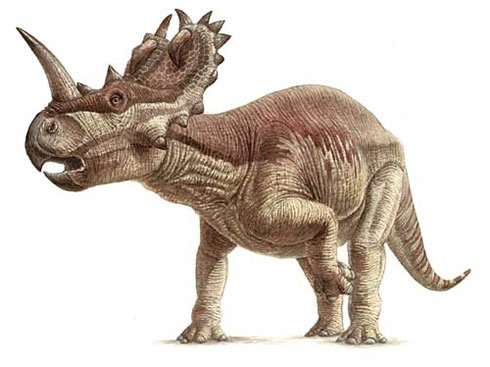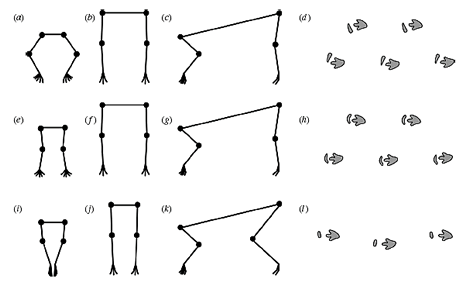Muscle reconstruction reveals how dinosaurs stood

(Phys.org) -- Much is known about the dinosaurs that walked on 4 legs like Stegosaurus and Triceratops, but their stance has been a topic of debate, until now. Scientists at the Natural History Museum have revealed how these dinosaurs stood for the first time, and report their findings today.
Museum dinosaur experts Susannah Maidment and Paul Barrett reconstructed the muscles on dinosaur limb bones and combined this with what is already known about their skeletons to get a truer picture of how they stood.
The team looked at the horned dinosaurs (ceratopsids), the armoured dinosaurs (stegosaurs), and the duck-billed dinosaurs (hadrosaurs), 3 groups of ornithischian dinosaurs.
They studied more than 200 dinosaur fossil bone specimens, looking at how muscles and soft tissue attach to forelimbs, hind limbs, hip bones and vertebrae.
The results suggest the front limbs of the ceratopsids and the stegosaurs had elbows that were bent and held slightly out from the sides of the body (as though it was half-way through a press up). In comparison the hadrosaurs held their forelimbs quite close together.
Until now, scientists have just used the fossil skeletons to reconstruct what a dinosaur looked like. However, the team says the skeleton alone isn't a good predictor of how the animal stood, and it is crucial to look at the soft tissue as well. This also has implications for scientists who study behaviour and biology in other extinct animals.
'What this work shows is that before we can make any sweeping statements about the biology of dinosaurs, or any other extinct animals, we have to try hard to understand the other, missing pieces of their anatomy. We can't just rely on their bones,' says Barrett.

Reconstructing muscles
As soft tissues such as muscles rarely fossilise, scientists use data from the dinosaurs' closest living relatives, birds and crocodiles.
'If a muscle is present in birds, and it is also present in crocodiles, then we can be quite sure it was also present in the dinosaurs,' says Maidment. 'By looking at all of the limb muscles in crocodiles and birds through dissection, we can build up a picture of the limb muscles in the dinosaurs.'
Comparing dinosaurs
The ancestors of ceratopsids, stegosaurs and hadrosaurs were bipedal, meaning they walked on 2 legs. However, these 3 distinct but closely related dinosaur groups evolved independently, to become quadrupedal, walking on 4 legs. Even though they evolved separately, their skeletal anatomy was very similar.
Different muscles
Although their skeletons were very similar, the team found that the muscles were different, showing the ornithischian dinosaurs had more diverse methods of locomotion than previously thought.
"We were surprised to find just how different the courses of these muscles were in the different quadrupedal dinosaur groups, despite the overall similarities in the anatomy of their leg, shoulder and hip bones," says Barrett.
"Our work shows that the shape of the bones alone does not tell the full story, and that it is really important to reconstruct the soft tissues as well to work out how these dinosaurs stood," says Maidment.
Hadrosaur fossil tracks
The team’s reconstructions show that the hadrosaurs held their forelimbs quite close together and placed one foot in front of the other along a midline as they walked. Fossilised hadrosaur tracks seem to show the same thing.
Future research
Now scientists have a clearer picture of how these dinosaurs stood, the next step is to investigate how they actually moved. "We've already begun doing this and are producing 3D computational models of the limbs to look at how the muscles worked as the animals moved," concludes Maidment.
Provided by Natural History Museum




















